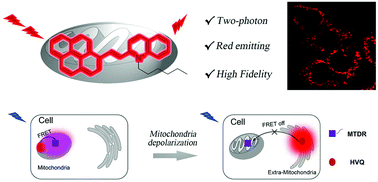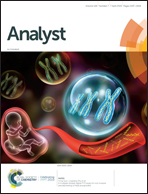A two-photon excited red-emissive probe for imaging mitochondria with high fidelity and its application in monitoring mitochondrial depolarization via FRET†
Abstract
Mitochondria play central roles in plenty of biological processes, such as apoptosis, signaling, and cell differentiation. Mitochondrial depolarization is a significant sign of deterioration of intracellular status. Although many fluorescent probes for visualizing mitochondria have been delivered, two-photon red-emitting mitochondrial probes capable of detecting mitochondrial depolarization remain rare. In this work, by linking a pyrene moiety to a quinoline salt, we have constructed two-photon red-emitting mitochondrial probes, MVQ and HVQ. Between them, HVQ with a longer side chain exhibits higher hydrophobic properties, and can image mitochondria with high-fidelity due to the aggregation caused quenching effect. In cooperation with MTDR, a commercialized mitochondrial probe, HVQ, could be used to image the depolarization of mitochondria induced by a protonophore and hydrogen peroxide. We believe that HVQ can serve as a powerful tool for the investigation of mitochondria and mitochondrial membrane potential in fundamental biological research.



 Please wait while we load your content...
Please wait while we load your content...